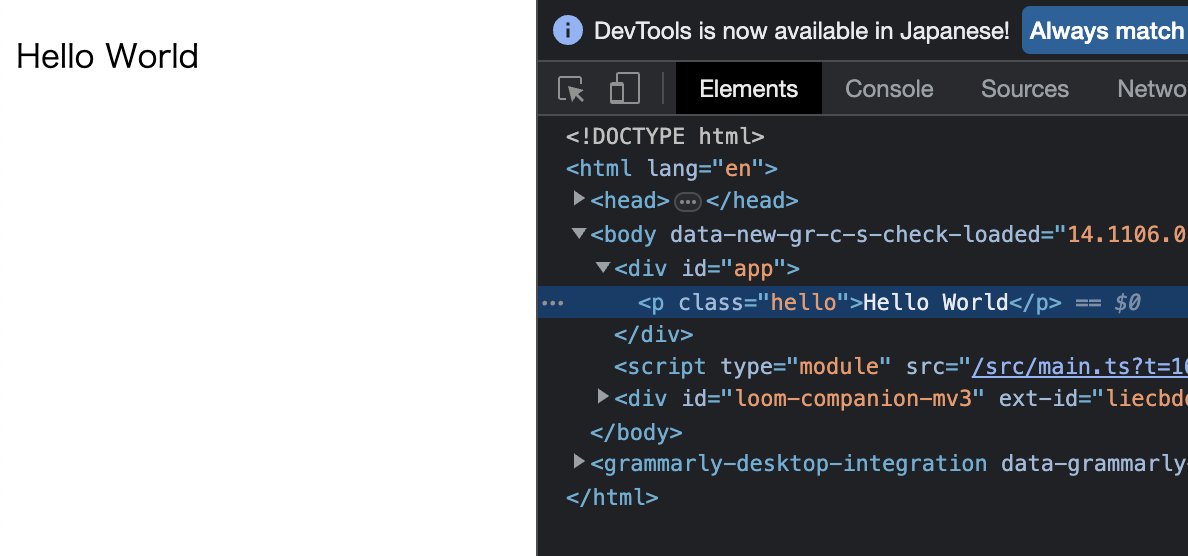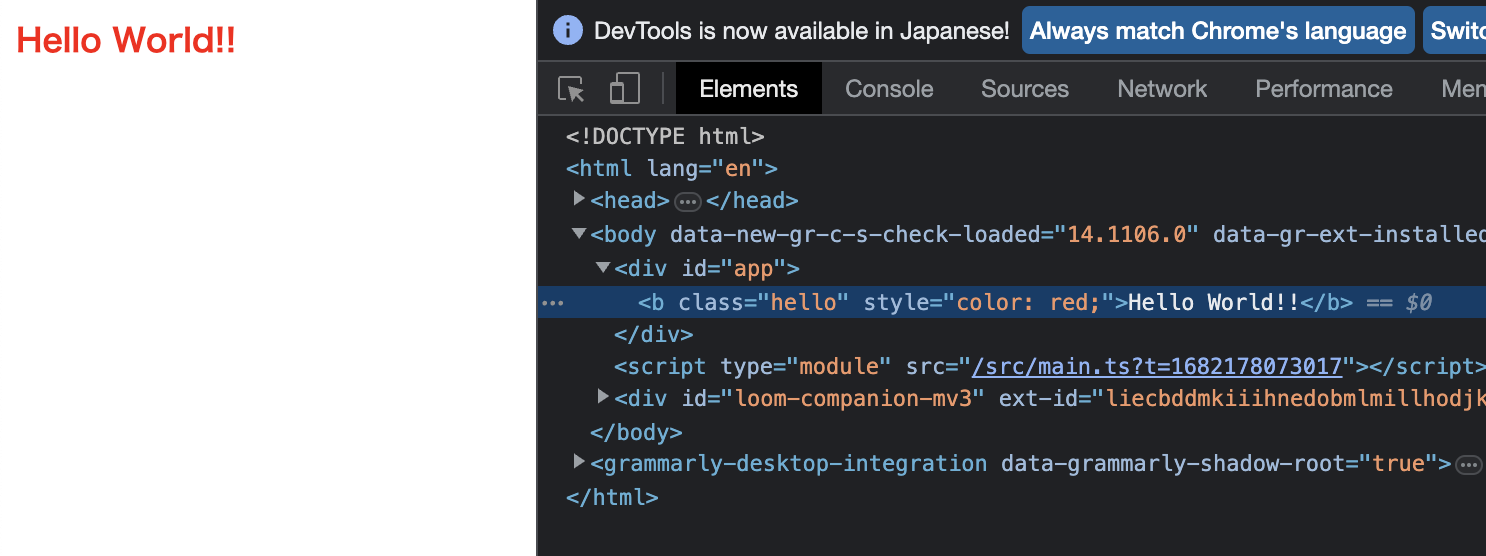实现模板编译器
实现方法
基本的方法是处理template选项中传递的字符串,生成特定的函数。
我们将编译器分为三个部分。
解析
解析(parse)从传递的字符串中提取必要的信息。
以下是一个简单的例子:
const { tag, props, textContent } = parse(`<p class="hello">Hello World</p>`)
console.log(tag) // "p"
console.log(prop) // { class: "hello" }
console.log(textContent) // "Hello World"代码生成
代码生成(codegen)基于parse的结果生成代码(字符串)。
const code = codegen({ tag, props, textContent })
console.log(code) // "h('p', { class: 'hello' }, ['Hello World']);"函数对象生成
基于codegen生成的代码(字符串),创建实际可执行的函数。
在JavaScript中,我们可以使用Function构造函数从字符串生成函数。
const f = new Function('return 1')
console.log(f()) // 1
// 如果需要定义参数,可以这样做
const add = new Function('a', 'b', 'return a + b')
console.log(add(1, 1)) // 2我们将使用这个方法生成函数。
这里有一点需要注意,生成的函数只能处理在其中定义的变量,所以我们需要包含h函数等的导入。
import * as runtimeDom from './runtime-dom'
const render = new Function('ChibiVue', code)(runtimeDom)这样,我们可以用ChibiVue这个名称接收runtimeDom,所以在codegen阶段需要提前准备好h函数的导入方式:
const code = codegen({ tag, props, textContent })
console.log(code) // "return () => { const { h } = ChibiVue; return h('p', { class: 'hello' }, ['Hello World']); }"也就是说,我们之前提到的转换:
`<p class="hello">Hello World</p>`
// ↓
h('p', { class: 'hello' }, ['Hello World'])更准确地说,应该是:
`<p class="hello">Hello World</p>`
// ↓
ChibiVue => {
return () => {
const { h } = ChibiVue
return h('p', { class: 'hello' }, ['Hello World'])
}
}我们将这个结果传递给runtimeDom,生成render函数。
而codegen的职责是生成如下字符串:
const code = `
return () => {
const { h } = ChibiVue;
return h("p", { class: "hello" }, ["Hello World"]);
};
`实现
理解了方法后,让我们开始实现。在~/packages目录中创建compiler-core目录,并在其中创建index.ts、parse.ts和codegen.ts文件。
pwd # ~/
mkdir packages/compiler-core
touch packages/compiler-core/index.ts
touch packages/compiler-core/parse.ts
touch packages/compiler-core/codegen.tsindex.ts像往常一样仅用于导出。
让我们从parse开始实现。packages/compiler-core/parse.ts
export const baseParse = (
content: string,
): { tag: string; props: Record<string, string>; textContent: string } => {
const matched = content.match(/<(\w+)\s+([^>]*)>([^<]*)<\/\1>/)
if (!matched) return { tag: '', props: {}, textContent: '' }
const [_, tag, attrs, textContent] = matched
const props: Record<string, string> = {}
attrs.replace(/(\w+)=["']([^"']*)["']/g, (_, key: string, value: string) => {
props[key] = value
return ''
})
return { tag, props, textContent }
}虽然这是一个使用正则表达式的非常简单的解析器,但作为第一次实现已经足够了。
接下来,是代码生成。在codegen.ts中实现。packages/compiler-core/codegen.ts
export const generate = ({
tag,
props,
textContent,
}: {
tag: string
props: Record<string, string>
textContent: string
}): string => {
return `return () => {
const { h } = ChibiVue;
return h("${tag}", { ${Object.entries(props)
.map(([k, v]) => `${k}: "${v}"`)
.join(', ')} }, ["${textContent}"]);
}`
}现在,我们将这些结合起来,实现一个从template生成函数字符串的函数。创建一个新文件packages/compiler-core/compile.ts。packages/compiler-core/compile.ts
import { generate } from './codegen'
import { baseParse } from './parse'
export function baseCompile(template: string) {
const parseResult = baseParse(template)
const code = generate(parseResult)
return code
}这应该不太难理解。实际上,compiler-core的职责就到此为止。
运行时编译器和构建过程编译器
Vue实际上有两种类型的编译器。
一种是在运行时(浏览器中)执行的编译器,另一种是在构建过程(如Node.js环境)中执行的编译器。
具体来说,运行时编译器处理template选项或作为HTML提供的模板,而构建过程编译器处理SFC(单文件组件)或JSX。
template选项就是我们现在正在实现的内容。
const app = createApp({ template: `<p class="hello">Hello World</p>` })
app.mount('#app')<div id="app"></div>作为HTML提供的模板是指在HTML中直接编写Vue模板的开发者接口。(通过CDN引入时很方便快速地嵌入到HTML中。)
const app = createApp()
app.mount('#app')<div id="app">
<p class="hello">Hello World</p>
<button @click="() => alert('hello')">click me!</button>
</div>这两种情况都需要编译模板,而编译过程发生在浏览器中。
另一方面,SFC的编译是在项目构建时进行的,运行时环境中只存在编译后的代码。(开发环境需要配置vite或webpack等打包工具。)
<!-- App.vue -->
<script>
export default {}
</script>
<template>
<p class="hello">Hello World</p>
<button @click="() => alert("hello")">click me!</button>
</template>import App from 'App.vue'
const app = createApp(App)
app.mount('#app')<div id="app"></div>值得注意的是,无论哪种编译器,都有共同的处理部分。
实现这些共同部分的源代码位于compiler-core目录中。
而运行时编译器和SFC编译器分别实现在compiler-dom和compiler-sfc目录中。
请在此时回顾一下这张图:
https://github.com/vuejs/core/blob/main/.github/contributing.md#package-dependencies
继续实现
刚才我们有点跑题了,让我们继续实现编译器。
考虑到前面的讨论,我们现在创建的是运行时编译器,所以应该创建compiler-dom目录。
pwd # ~/
mkdir packages/compiler-dom
touch packages/compiler-dom/index.ts在packages/compiler-dom/index.ts中实现代码。
import { baseCompile } from '../compiler-core'
export function compile(template: string) {
return baseCompile(template)
}你可能会想:"啊?这不是只做了代码生成吗?函数的生成在哪里?"
实际上,在这里我们也没有生成函数,而是在packages/index.ts中进行。(在Vue源码中,对应的是packages/vue/src/index.ts)
在实现packages/index.ts之前,我们需要做一些准备工作。
这个准备工作是在packages/runtime-core/component.ts中添加一个保存编译器本身的变量和注册用的函数。
packages/runtime-core/component.ts
type CompileFunction = (template: string) => InternalRenderFunction
let compile: CompileFunction | undefined
export function registerRuntimeCompiler(_compile: any) {
compile = _compile
}现在,让我们在packages/index.ts中生成函数并注册它。
import { compile } from './compiler-dom'
import { InternalRenderFunction, registerRuntimeCompiler } from './runtime-core'
import * as runtimeDom from './runtime-dom'
function compileToFunction(template: string): InternalRenderFunction {
const code = compile(template)
return new Function('ChibiVue', code)(runtimeDom)
}
registerRuntimeCompiler(compileToFunction)
export * from './runtime-core'
export * from './runtime-dom'
export * from './reactivity'※ 由于runtimeDom需要包含h函数,所以别忘了在runtime-dom中导出它。
export { h } from '../runtime-core'现在我们已经注册了编译器,接下来要实际执行编译。
首先,我们需要在组件选项的类型中添加template字段。
export type ComponentOptions = {
props?: Record<string, any>
setup?: (
props: Record<string, any>,
ctx: { emit: (event: string, ...args: any[]) => void },
) => Function
render?: Function
template?: string // 添加
}对于核心的编译部分,我们需要对渲染器进行一些重构。
const mountComponent = (initialVNode: VNode, container: RendererElement) => {
const instance: ComponentInternalInstance = (initialVNode.component =
createComponentInstance(initialVNode))
// ----------------------- 从这里
const { props } = instance.vnode
initProps(instance, props)
const component = initialVNode.type as Component
if (component.setup) {
instance.render = component.setup(instance.props, {
emit: instance.emit,
}) as InternalRenderFunction
}
// ----------------------- 到这里
setupRenderEffect(instance, initialVNode, container)
}我们将上面mountComponent中的部分提取到packages/runtime-core/component.ts中。
packages/runtime-core/component.ts
export const setupComponent = (instance: ComponentInternalInstance) => {
const { props } = instance.vnode
initProps(instance, props)
const component = instance.type as Component
if (component.setup) {
instance.render = component.setup(instance.props, {
emit: instance.emit,
}) as InternalRenderFunction
}
}packages/runtime-core/renderer.ts
const mountComponent = (initialVNode: VNode, container: RendererElement) => {
// prettier-ignore
const instance: ComponentInternalInstance = (initialVNode.component = createComponentInstance(initialVNode));
setupComponent(instance)
setupRenderEffect(instance, initialVNode, container)
}现在,让我们在setupComponent中执行编译。
export const setupComponent = (instance: ComponentInternalInstance) => {
const { props } = instance.vnode
initProps(instance, props)
const component = instance.type as Component
if (component.setup) {
instance.render = component.setup(instance.props, {
emit: instance.emit,
}) as InternalRenderFunction
}
// ------------------------ 这里
if (compile && !component.render) {
const template = component.template ?? ''
if (template) {
instance.render = compile(template)
}
}
}现在我们应该能够编译通过template选项传递的简单HTML了,让我们在playground中测试一下!
const app = createApp({ template: `<p class="hello">Hello World</p>` })
app.mount('#app')
看起来运行得很好。只要结构相同,就应该能够编译,让我们修改一下看看是否能够正确反映。
const app = createApp({
template: `<b class="hello" style="color: red;">Hello World!!</b>`,
})
app.mount('#app')
看来我们的实现正常工作了!
到目前为止的源代码:
chibivue (GitHub)
 The chibivue Book
The chibivue Book